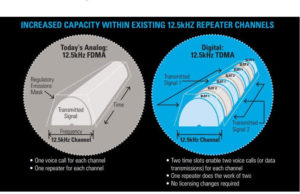Is It Time to Migrate to Digital? Part Two: Better Capacity
Case Study, Digital Radios, News | 0 comments | by Vanessa ChavezIn Part Two of this series on Digital Migration, we discuss Better Capacity.

Part Two: Better Capacity
Regulatory pressures and real-world needs are driving a demand to expand the capacity of the business designated slice of the RF spectrum by leveraging new technology. As it happens, digital two way radio technology is very bandwidth efficient and actually allows two separate “channels” to operate on a single 12.5 kHz frequency. Effectively doubling its capacity. (See chart Above)
In addition to making efficient use of the RF spectrum, this feature helps minimize licensing costs associated with operational expansion because the additional channels do not require additional frequencies. For a fast growing business that is expanding its radio operations this can mean significant savings while expanding communications.
“Two technologies exist to enable this “splitting” of channels,allowing multiple-access on a single channel. Frequency Division Multiple Access (FDMA) splits the channel frequency into two smaller sub-channels that can carry separate calls side-by-side. Time-Division Multiple Access (TDMA) preserves the full channel width, but divides it into alternating time slots that can each carry an individual call.”
Both technologies are already being used in North America to accomplish the FCC-mandated split of 25 kHz channels into 12.5 kHz channels. They’re both being used worldwide to accomplish similar increases in spectral efficiency whether currently mandated or not.
In the coming years, new regulations will almost certainly require improvements in the effective capacity of 12.5 kHz channels: it is only a matter of time before the ability to carry two voice paths in a single 12.5 kHz channel — also known as 6.25 kHz equivalent efficiency — becomes a requirement. But because the technology exists today to accomplish this goal, there’s no need for professional radio users to wait for the regulations to catch up with benefits that are immediately available……. Spectral Efficiency Analog radios have been used in business-critical applications for years.
However, as manufacturers introduce high power digital radios to this market, they have a choice:
- they can either build their communications system using a proprietary technology such as digital 6.25 kHz FDMA
- or they can leverage standards-based TDMA. The two are not compatible or inter-operable
Motorola believes that two-slot TDMA is the best fit for most professional, business-critical digital two-way radio applications. Moreover, ETSI has selected TDMA as the standard protocol for Tier-2 professional two-way radio applications. It satisfies ETSI channel emissions requirements and goals for spectral efficiency.
Although the FCC does not mandate standard protocols, devices conforming to the ETSI Tier-2, two-slot TDMA standard will meet existing FCC channel emissions requirements for 12.5 kHz channels. Because this exceed forward-looking requirements for spectral efficiency in the U.S. with technical advantages for the professional market. The backing of the world’s most influential telecommunications standards bodies, two-slot TDMA is the clear choice for organizations looking to deploy new digital two-way radio systems.

